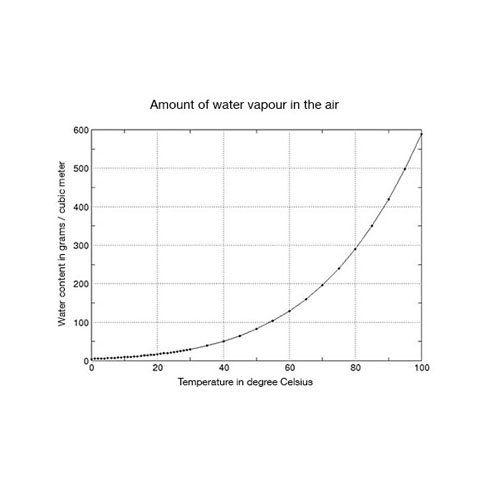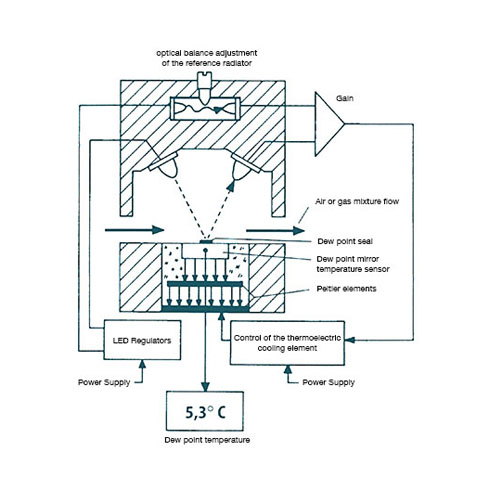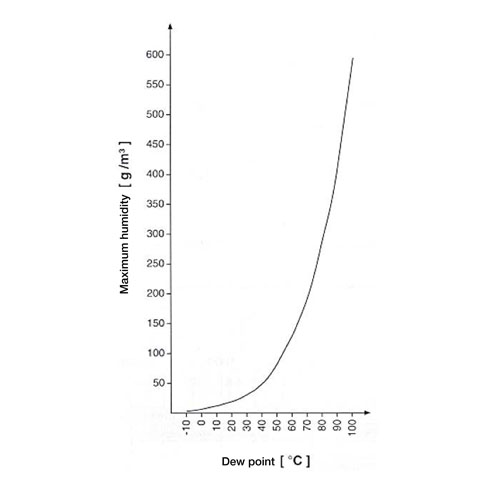Knowledge from the field of thermodynamic calibration
The knowledge page on thermodynamic measurands answers questions about temperature and humidity calibration. You will get an insight into which possibilities and measuring instruments are available for the two calibrations.
Here you will find answers to the following questions:
- What are the humidity parameters?
- Why do moisture meters need to be calibrated?
- Possibilities of humidity calibration?
- How to calibrate a hygrometer?
- What is a dew point hygrometer?
- What humidity sensors are available?
- How does a polymer sensor work?
- How are temperature measuring instruments calibrated?
- What are the methods of temperature measurement?
- What sensors are available in the temperature range?
- Temperature calibration options
- Calibration in liquid baths
- Calibration in circulators and overflow basins
- What is dew point (dew point temperature) °Ctp?
Why do moisture meters need to be calibrated?
The decisive factor for process precision and cost savings - even with long-term stable sensor technology - is regular calibration and possible readjustment. If this does not happen, there is a risk of having to define the humidity target interval more narrowly after just one or two years, with considerable effects on operating costs. For the person responsible for the test equipment or the system, it is crucial to have a complete system that is suitable for the moisture analyser and that enables this calibration and adjustment with little effort.
What are the humidity parameters?
The absolute humidity fabs [g/m³] indicates the mass of water contained in a volume in the form of vapour. With constant air volume, the absolute humidity is independent of temperature and pressure. If, however, the volume decreases due to external pressure effects or cooling while the water content remains constant, the absolute moisture content increases accordingly.
The saturation humidity or maximum humidity fmax [g/m³] indicates the maximum possible amount of water vapour in one cubic metre of air at a given temperature. In this case, the moisture absorption capacity of the air increases as the temperature rises. However, if the maximum humidity is exceeded, the excess water vapour precipitates in the form of condensate (droplet formation) precipitate.

The relative humidity U [%rh] is the ratio between the contained and the maximum possible mass of water vapour in the air. In addition, relative humidity relates the moisture content to saturation and is therefore a measure of the saturation deficit in the air. Thus, relative humidity indicates the percentage of the maximum possible amount of water vapour that is currently present in the air.
Possibilities of humidity calibration
Humidity calibration options: The following measuring methods and measuring systems are preferably used to calibrate humidity measuring instruments/data loggers/transmitters:
- Damp cloth / damp rag method
- Fixed point cells/salt pots
- Two-quantity generators
- Climate chamber
- Huminator
- Two-temperature/two-pressure generators
- Humidity generator Thunder
- Pressure dew point systems
How to calibrate hygrometer?
Compared to other measured variables (temperature, flow ...), the calibration of hygrometers is more difficult, since the generation of defined humidity represents a considerably higher effort. Specific problems such as adsorption/desorption phenomena or condensate precipitation occur above all in the trace and high moisture range. The following methods are suitable for calibrating hygrometers:
- Damp cloth / damp rag method
- Fixed point cells/salt pots

What is a dew point hygrometer?
The measuring principle of the dew point hygrometer is based on the cooling of the humid air until condensation occurs. The occurrence of condensing water on a temperature-controlled mirror is detected optically, namely when the mirror is just beginning to mist up. The temperature prevailing at this moment corresponds to the dew point temperature. A control device then keeps the mirror temperature constant at the dew point temperature, which can then be determined very precisely by means of platinum temperature sensors. A Peltier element is used for cooling, and the mirrored surface is evaluated by optoelectronic methods.
What humidity sensors are available?
A sensor (Latin sensus: "feeling") or (measuring) sensor is a technical component which, in addition to certain physical or chemical properties (e.g. thermal radiation, temperature, humidity, pressure, alternating sound pressure, sound, brightness, magnetism, acceleration, force), can also detect the material properties of its environment qualitatively or quantitatively as a measurand. Due to the large dynamic range and the fact that there are hardly any materials and physical effects that are not influenced by water vapour in the sample gas, there are a number of different sensor principles for determining humidity.
- Ceramic sensors
- Lithium chloride sensors
- Polymer sensors
- Resistive polymer sensors
- Capacitive polymer sensors
How does a polymer sensor work?
A polymer sensor uses the change in properties of a special plastic (polymer) depending on the humidity of the environment. Simple polymer sensors use the change in electrical resistance of a moisture-sensitive polymer layer (resistive polymer sensors), higher-end devices have metal surfaces attached to the sides of a small polymer plate and measure the change in the dielectric constant of the polymer as a change in the capacitance of the array (capacitive polymer sensors). If the measuring temperature is known, the relative humidity can be converted into an absolute humidity.
How are temperature measuring instruments calibrated?
The term "calibrating a thermometer" means determining the measurement deviation of the thermometer. The measurement deviation is the difference between the "correct" temperature of the thermometer and the displayed temperature or the output signal.
What are the methods of temperature measurement?
Depending on the temperature range and environmental conditions, different methods can be used. The most common are the so-called contact thermometers, where the medium to be measured is touched or immersed in it. The contrast is formed by the non-contact variant, which includes thermography or radiation thermometry. If direct measurements cannot be carried out, such as at very high temperatures, this method is a suitable alternative.
What sensors are available in the temperature range?
The selection of the correct sensor for measuring the temperature determines the accuracy of the measurement results. It should be noted that the different sensors have different requirements.
- A large measuring range usually means limited accuracy,
- particularly fast probes with short adjustment times are usually not suitable for robust everyday measurements,
- the design determines which probe is suitable for which measurements.
Overview of different sensors
- Resistance thermometer
- PTC thermistor (PTC sensor)
- Thermistors/thermistor sensors (NTC sensor)
- Platinum sensor (e.g. PT100)
- Thermocouple sensor
Temperature calibration options
Basically, a distinction is made between two calibration methods for temperature calibration: Calibration at fixed points and calibration by comparison measurement. In addition to these methods, there are various possibilities for calibrating test/measurement equipment and instruments traceable to the ITS 90:
- Calibration at fixed points
- Calibration in liquid (circulation or calibration) baths
- Calibration in metal block calibrators
- Calibration in tube furnaces
- Calibration on surfaces (contact and non-contact)
- Calibration in temperature/air conditioning cabinets
Calibration in liquid baths
In the calibration by comparison measurement, a standard thermometer and the test specimen are exposed to a constant temperature, which is generated, for example, in a stirred liquid bath or a metal block calibrator. The actual temperature in the device is measured with the standard and compared with the reading of the test item after a thermal equilibrium has been established between the thermometers and the contact material. For calibration, only stirred liquid baths should be used because the temperature distribution should be as uniform as possible. In the case of liquid baths, a basic distinction is made between circulation baths or circulation thermostats and so called overflow baths.
Calibration in circulators and overflow basins
In the case of liquid baths, a basic distinction is made between circulation baths or circulation thermostats and so-called overflow baths. Calibration in overflow basins: With this design, the bath fluid is circulated from the bottom to the top. Thus, a very homogeneous spatial temperature distribution and a high temporal temperature constancy are achieved within the basin. The advantage of the overflow basin compared to the circulation basin is the better temperature constancy, a uniform temperature distribution and the defined cylindrical useful space.

What is dew point (dew point temperature) °Ctp?
The dew point temperature is defined as the temperature at which the current water vapour content in the air (100% relative humidity) is at a maximum. The dew point temperature is independent of the current temperature. One way to measure the dew point temperature is to cool metal until the surface fogs with water vapour. Then the temperature of the metal is the dew point temperature. This effect is also used in various measurement and calibration procedures ("moist stocking method"; "dew point hygrometer").